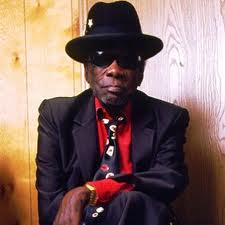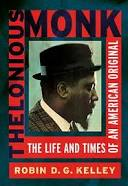 Thelonious Monk: The Life and Times of an American Original. Robin D. G. Kelley. 2009. Free Press.
Thelonious Monk: The Life and Times of an American Original. Robin D. G. Kelley. 2009. Free Press.
Much that has been written about Thelonious Monk is assumed to be mythical—narratives based upon hearsay and innuendo. In this interesting book the author attempts to present more truth about this man. The writer is an academic historian employed at the University of Southern California. He is working to explain the personality and motives of a very complex and accomplished musician who is no longer with us. The book is heavy in conjecture as well as content. It is in our nature to reach conclusions based upon incomplete evidence—it may be necessary for human survival. Also, memories of historical events are known to be faulty; strong conclusions derived from anecdotal evidence are not warranted here or in a courtroom. However, the research is ample and supported by footnotes. Many people thought to be close to Monk are quoted from interviews conducted by the author. Also cited here are statements documented by previous Monk chroniclers—quotes that are recollections of nieces, nephews, and other family members collected and written in earlier publications. And, there are numerous quoted comments and testimonials from Monk’s musician colleagues. I will include some of those here. The numbers in parentheses are page numbers from the book.
In 1934, Thelonious Monk dropped out of New York’s Stuyvesant High School–it was his junior year. Grades during his high school years were mediocre, and there were no extracurricular activities per the author’s research of Stuyvesant High School yearbooks. No organized sports. Two things he liked to do most were hang out at the community center and play music mostly in his family apartment. He had an upright piano, or was it a “player piano” with a roll? He learned to play, according to Monk, by watching his sister, who received lessons. Monk received professional lessons only after he demonstrated an ability and acute interest. Playing the piano was something he was good at, and respected for by his peers. His parents were separated and his Dad lived in North Carolina. His Mom and the children left Carolina when Thelonious was under 10 years of age. Most black women in need of income did domestic work; Barbara Monk worked as an office cleaning women. Thelonious lived mostly in his mother’s apartment on West 63rd Street in Manhattan well into his 30’s. Steady work was elusive; the author speaks of Monk for one day working as a laborer. Defying conventional work, he began working hard to become an income-earning pianist. Of course, this was during the Great Depression, and families encouraged children to add to the household income by leaving school early and getting a job.
Monk formed a band at this time and made a little money—maybe $10 for the band per engagement. He met a female black evangelist who asked Monk and his band mates to go on the road. “She preached and healed and we played (41).” “I always played jazz. I mean, I was playing church music the same way.” Two years on tour, but Monk had very little explanation then nor in later interviews, and he was not a religious adult. Why did he do this, when he could have stayed in NY and play music—no one knows. This is a “life and times” book and the writer goes into detail, but there are no explanations, only speculation. The reading gets rather arduous here, as the writer contrasts the bombastic proselytizing evangelists with the formal and conservative Baptist and Methodist churches. The music of the former bordered on rock and roll—Monk was doing this during the evangelist revival meetings; the latter more formalized religious units had their organized choirs and hymns. This is the historian providing rich background. It is presumed Monk matured as a musician during this period of rambunctious piano playing in church; the musical experiences were shaping the young man.
Dr. Kelley may exhaust you with his detailed descriptions of Monk’s in-laws and friends, their early occupations, home locations, and how they came to live in the San Juan Hill neighborhood of Manhattan. The community was large in Monk’s life and is honored with expanding detail. Kelley found rich source material by interviewing Monk family members. The neighborhood folks in the early-Monk story are mostly of West Indian or Caribbean descent, light-skinned, and attractive. Monk, however, was descended from African slaves that resided in North Carolina. Kelley describes interpersonal conflicts people of color have experienced that are attributed to shades of blackness differences between combatants–interesting historical background for the patient reader.
Monk’s dad was named Thelonious, and the third child of Monk’s brother Thomas was named Theolonious—not my spelling error but that of Monk’s sister-in-law who misspelled the name on the birth certificate application. At the time of this nephew’s birth it was thought that Monk may not succeed as a musician, never marry, nor have offspring. This naming was an attempt to continue the legacy of the grandfather (Monk’s father), per an author interview with the nephew Theolonious. Monk was “uncommon,” beginning with this grand name his father, he, and the nephew bore.
Monk’s technique on the piano at this time is described by other musicians. Billy Taylor met Monk in the presence of a group of pianists practicing a cutting session in the back of a club—present were Willie “The Lion” Smith and James P. Johnson, along with Monk. Hearing Monk play, Taylor noted he was playing like pianist Art Tatum, but he did not really sound like him or Willie “The Lion.” Quoting Taylor, “. . . and he (Monk) sat down and played a standard. I believe it could have been ‘Tea for Two.’ It doesn’t sound like anybody but Monk and this is what he wanted to do. He had the confidence. The way that he does those things is the way he wanted to do them (54).” And from pianist Teddy Wilson, “Thelonious Monk knew my playing very well, as well as that of Tatum, Earl Hines, and Fats Waller. He was exceedingly well grounded in the piano players who preceded him, adding his own originality to a very sound foundation.”
Author Kelley put it more technically, “He heard players ‘bend’ notes on the piano, or turn the beat around, or create dissonant harmonies with ‘splattered notes’ and chord clusters . . . displace the rhythm by playing in front or behind the beat . . . throw listeners momentarily off-track. Monk embraced these elements in his own playing and exaggerated them (55).” Monk learned from the stride piano players but his dissonance techniques went further to effect his own modern style.
In January of 1941 Monk became the house pianist at Minton’s Playhouse, and helped stamp this club as the legendary birthplace of bebop, or modern jazz. Here is how Kelley describes it: “Charlie Parker and Dizzy Gillespie stood at its helm, playing circles around the old legends; Bud Powell transformed his piano into a horn at blistering tempos; drummer Kenny Clarke, guitarist Charlie Christian, and bassist Oscar Pettiford revolutionized rhythm; pianist Tadd Dameron wrote and arranged bebop anthems; and the wacky, eccentric Thelonious Monk taught his peers harmony and confused the hell out of everybody (61).” Kelley points out that in interviews Monk reminded the public that these story lines played out over a period of maybe ten years as the style evolved and transformed jazz music. Monk may have lost his steady nightly gig by year-end, but he continued for many years to attend the Monday night Minton jam sessions at which all of these players were regular drop-ins. Monk began composing great songs in 1941 while attending these sessions.
To further explain this phenomenon occurring at Minton’s, Kelley produces a Monk quote from a 1956 piece in Down Beat: “I had no particular feeling that anything new was being built. Its true modern jazz probably began to get popular there. But as for me, my mind was like it was before I worked in Minton’s.” And this statement from Kenny Clarke: “You know, we hadn’t really set out with the idea of developing any particular style of jazz. It was really unconscious (70).” Some of the 1940’s Minton sessions were recorded by a young Columbia University student named Jerry Newman; he used a portable Wilcox-Gay Recordio “disc-cutter” that recorded on to a 12-inch aluminum-based acetate disc or on a plastic-coated version that cost seven cents. Newman was able to broadcast some of these “records” on the C. U. campus radio station. Some of these discs are still available, although Newman says he ruined them by playing his trombone during the live on-stage recording. Monk has used these recordings to prove to the critics that he truly has technique and could play fast runs, but did what he chose to do; i.e. be himself! He preferred medium tempos and dissonant harmonies to what was popular.
Unemployed and short on club gigs, Monk spent his free time composing music wherever he found himself–at his mother’s apartment on his upright, at Shorty Smith’s house (another piano player), or anywhere he could play another’s piano with permission and at any time night or day, such as the apartment of Billy Taylor or at the home of his friend Mary Lou Williams. These friends would wake up to the sound of Monk tinkling the keys in their living room.
The commencement of WWII brought draft notices to the musicians. The prevailing view was that black musicians would fight battles on two fronts: first, make an effort to desegregate the army while fighting fascism in Europe; and secondly, battle the Jim Crow segregation laws at home. Blacks were not highly motivated to enlist. With their increased presence in the streets of Harlem, race riots and events of police brutality prevailed. Many of the establishments providing work for the musicians closed down—Monk’s second stint at Minton’s Playhouse suffered this fate and he was out of work again. At this time the musicians went downtown for work and the 52nd Street scene began to take shape; bebop had not yet been recognized.
Monk began to publish and copyright his compositions in 1944. His first inking was “52nd Street Theme,” a piece he originally titled “Bip Bop” that was picked up by several bands and favored as an opening/closing theme at various clubs. Everyone was playing it; however, he never recorded it–Dizzy Gillespie did so, on the RCA Victor label. Thelonious did not earn any money off it because he did the copyright under another title.
When struggling with the legal nuances and rights protection in the music composition field, a big break came Monk’s way when Coleman Hawkins offered him a job. Hawk, a swing era stalwart, had a popular hit, “Body and Soul,” at the time. He liked Monk’s approach to harmony and designated Monk as the new band’s arranger. A transformation in jazz styles was occurring. The Hawkins band personnel in February, 1944, included Hawkins, Monk, Don Byas on tenor, Little Benny Harris on trumpet, Eddie Robinson on bass, and Denzil Best the drummer. They played thru the summer at the Down Beat Club; by mid-year Byas and Harris were gone, but the rhythm section remained and with the addition of Vic Coulsen the band played the “Black Broadway” district in Washington, DC. Returning to New York, the Hawkins quintet played the Apollo Theatre for a week. That engagement evoked the following review from Herbie Nichols, a classically trained pianist writing in the black-owned jazz magazine Music Dial, “Thelonious Monk is an oddity among piano players. This particular fellow is the author of the weirdest rhythmical melodies I’ve ever heard. They are very great, too. . . he seems to be partial to certain limited harmonies which prevent him from taking a place beside Art (Tatum) and Teddy (Wilson). He seems to be in a vise as far as that goes and never shows any signs of being able to extricate himself (98-99).”
In October of 1944 Hawkins took Monk, Best, and Robinson into the studio and recorded two 78 rpm platters, approximately eleven and a half minutes of four tunes–two ballads and two swing numbers: “Recollections,” “ Drifting on a Reed,” “On the Bean,” and “Flying Hawk.” These were Hawkins compositions and being of short duration, Monk had few and relatively short soloes. Monk’s own composition “Round Midnight” was then being arranged and/or recorded by both Bud Powell for the Cootie Williams Orchestra and his friend and pianist Mary Lou Williams. Kelley writes at length of Monk compositions being recorded by others under different titles and the practice of “borrowing” phrases or whole songs, or the flat-out poaching by band leaders of songs written by sidemen. Compositions got passed around without credit being given to the writer. It is also stated that Monk may have done a bit of this as well—it was a common practice.
In 1947 Bill Gottlieb, a writer/photographer for Down Beat, introduced Monk to Alfred and Lorraine Lion. Lion was the founder of Blue Note Records. Down Beat had just done a photo profile of Monk; the Lions were considering signing Monk to a recording contract. In his apartment with the Lions as audience, Monk played a full version of “Round Midnight,” “What Now,” “Ruby, My Dear,” and other yet unnamed pieces. Lorraine Lion (later Gordon) remarked that “Monk made the transition for me (from thoughts of Sidney Bechet and Duke Ellington), because I was hearing his great stride piano style from James P. Johnson and the blues and his great left hand.” Monk was allowed to assemble his own ensemble. For the first session Monk had a sextet; deemed a success, Blue Note had him back in the studio in a few days in a trio format—Gene Ramey on bass and Art Blakey on drums. They made six sides (one song per side of the 78 rpm records)–four Monk originals and two standards. The Lions felt the music was so great they should do more; in the final session Monk added two horn players, George Taitt and Sahib Shihab. Added to the list of recorded songs were “In Walked Bud,” “Who Knows,” “Monk’s Mood,” and “Round Midnight.” The first actual record was released in January, 1948—“Thelonious” on Side A and “Suburban Eyes” on the B side. This was the first Monk-led recording playable on a phonograph record player. Lorraine Lion, the Blue Note marketing department, worked tirelessly to promote Monk’s name throughout the music industry, ensuring he did not get pushed into the background as he had been before. But, progress on this front was slow due in part to trouble with the law.
In the summer of 1948 Monk was busted for marijuana possession and served 30 days in “the Tombs,” the Manhattan House of Detention. Kelley says that at this time in jazz circles, pot was as common as tobacco. However, city officials were out “to clean up 52nd Street and the Times Square area, which in their view had become a haven for crime, vice, and drug use. Thelonious had been caught in the dragnet (143).” In addition to doing time, he lost his cabaret license for a year. He was banned from working in alcohol-serving establishments in NYC.
With Lorraine’s help, Monk took his quartet into the Village Vanguard, a bohemian joint for folkies and poets, but bombed. The complaint was that the music was not suitable for dancing. With Billy Taylor’s band on standby contract with Vanguard owner Max Gordon, Monk and band were sent on their way. Monk would also play the 845 Club in Bronx where the cabaret law was not well-enforced. Here Monk jammed with fellow pianists Elmo Hope and Bud Powell; also, saxophonists Jackie McLean and Johnny Griffin were collaborating with Monk. The work was not steady. In early 1949 the jazz scene on 52nd Street died as “many clubs closed down or became striptease joints (148);” these were subsequently busted by city officials in a crackdown on burlesque. Ultimately, developers moved in and the neighborhood disintegrated. Musicians had to pursue out-of-town employment.
Monk continued to be ostracized for his weirdness (the word “weird” appears frequently in this book); the eccentric behavior, being late, or not showing up for a gig. Apparently, he got this reputation for unexplained absence in part due to not even being contracted for the job; promoters put his name on the bill to draw a paying audience and he was blamed for not being there. Everyone focused on his behavior; his genius at the keys was of secondary interest or misunderstood. Nevertheless, it was Monk who was creating the “modern music” – a term he preferred to “bebop.” Gillespie and Parker were making the money practicing the style of Monk, while Monk was starving as penalty for his “weirdness”. His celebrity status had been incubated, however. The press was sparking interest in his music, and the photographers highlighted his ever-present shades and French beret.
In early 1949, Kelly says Down Beat magazine wrote a critical review of Monk’s “Epistrophy,” concluding with the comment “nothing happens.” And the work “Evidence” provoked the following comment “can only appeal to the more atonally minded of the jazz gentry.” And, “Ruby, My Dear” is merely dismissed as “abstract (150).” That is from issues of Down Beat. But there was the rare favorable review of the Blue Note recordings of this period. Paul Bacon, writing in The Record Changer, “described ‘Ruby’ as a beautiful tone poem, played with great feeling and color, and praised his solo on ‘Evidence’ for its unity, a result of Monk’s habit of thinking of things as a whole, instead of a bar here and a bridge there (149).”
However, Monk could not sustain critical acclaim. In the company of Bud Powell, he was busted for possession of narcotics. Although insisting it was not his heroin, Monk was sent to a workhouse on Riker’s Island and Powell was transferred to a psychiatric ward. Unable to make bail, Monk served sixty days and was released the day of his court hearing. In detention, he worked in the bakery or shipping room. Then his luck changed—after three years of scattered gigs and loss of cabaret card, Blue Note offered to reissue previously recorded seven sides on a ten-inch LP titled The Genius of Modern Music—Monk’s first long-playing album and an event marking the end of 78’s.
This review of a literary piece describing the life of an American original is far from complete, but highlights the first 200 book pages and 30-plus years in the life of its subject. In your read, expect a serious historical work that is supported by more than three thousand footnotes of documentation. At this point in Monk’s life, he had defined himself as a musical artist and was well-known, but was not making much money. He had become his own man in the music business, and the story of his maturation was nearing completion. Appearing on the original The Tonight Show, Steve Allen described him as a “musician’s musician.” He was listened to by musicians and mostly respected, but some found him difficult to work with—read especially the sessions with Miles Davis or the testimony of numerous vocalists. Financial life got better, but the personal struggles continued–his mental health was an issue. To learn more on these matters and obtain an education on the origins of bebop and Monk’s “modern music,” read the book in its entirety!
Peter Furlong, PhD, volunteers at public radio station KUVO 89.3FM in Denver, CO, USA.
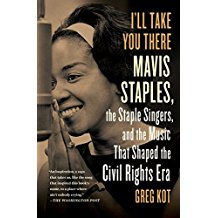 Kot, Greg. I’ll Take You There: Mavis Staples, The Staple Singers, and the March Up Freedom’s Highway. Scribner: New York. 2014.
Kot, Greg. I’ll Take You There: Mavis Staples, The Staple Singers, and the March Up Freedom’s Highway. Scribner: New York. 2014.
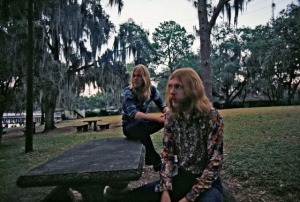

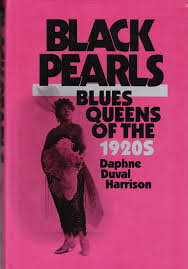
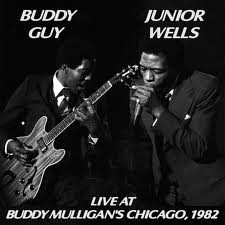

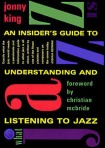

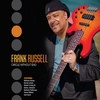
 For the last show of the day (that I was able to catch) it was with pen again in-hand taking notes that I experienced the Ben Paterson Organ Quintet. Paterson (pictured at left) seemed to enjoy and excel at talking to his huge audience at the West Stage at the Midway Plaisance near 60th Street and Ellis Avenue. I made note of his between-song quips. After playing a strong groove Jimmy McGriff “blues” tune, Paterson said, “There is not nearly enough blues in New York. It’s great to be back in Chicago playing some blues.” Spoken by a man who knows–although now based in New York, Paterson said he went to school here (UC) and identified the locations of his former Hyde Park apartments. The musicians in this group are young and they stepped up and played. The second song was the jazz standard, “Perdido,” composed by Juan Tizol and first recorded by Duke Ellington in 1942.
For the last show of the day (that I was able to catch) it was with pen again in-hand taking notes that I experienced the Ben Paterson Organ Quintet. Paterson (pictured at left) seemed to enjoy and excel at talking to his huge audience at the West Stage at the Midway Plaisance near 60th Street and Ellis Avenue. I made note of his between-song quips. After playing a strong groove Jimmy McGriff “blues” tune, Paterson said, “There is not nearly enough blues in New York. It’s great to be back in Chicago playing some blues.” Spoken by a man who knows–although now based in New York, Paterson said he went to school here (UC) and identified the locations of his former Hyde Park apartments. The musicians in this group are young and they stepped up and played. The second song was the jazz standard, “Perdido,” composed by Juan Tizol and first recorded by Duke Ellington in 1942.